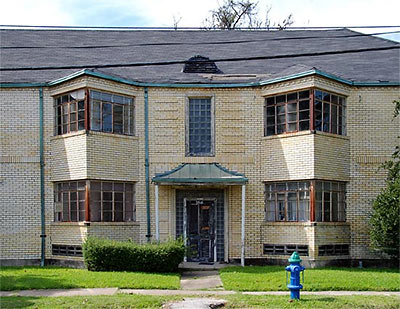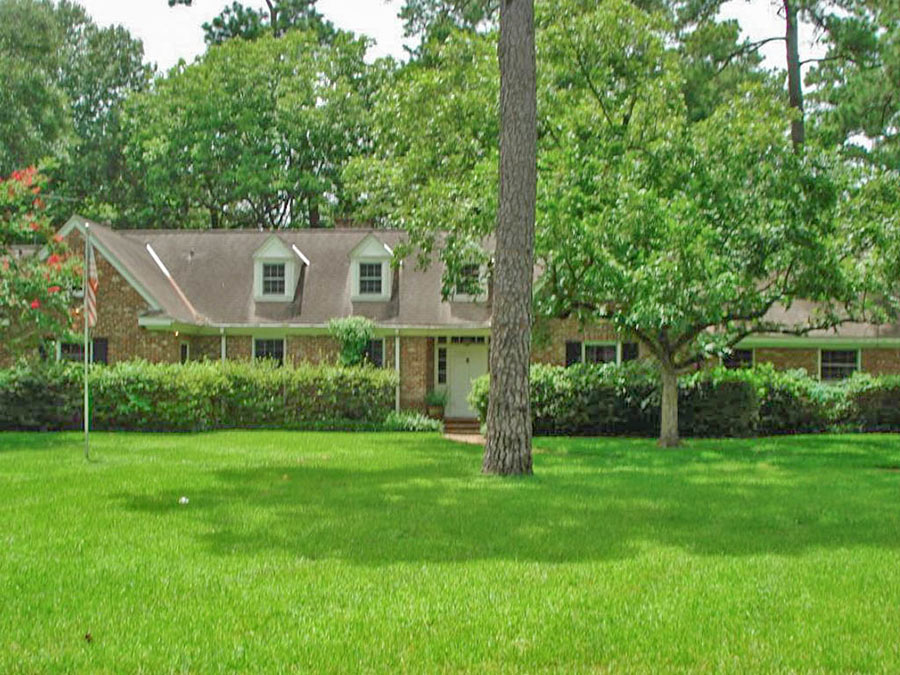
As noted in today’s Daily Demolition Report below, 20 structures of the Wilshire Village garden apartments at the corner of Alabama and Dunlavy received demolition permits yesterday.
Aren’t there only 17 buildings in the complex? Maybe everyone’s just trying to be extra sure to get them all.
If you’re coming late to this story — or if you just feel the need to relive all the excitement, mystery, and wackiness surrounding the long decline, eventual abandonment, and destruction of a 69-year-old Montrose icon — you can read all of Swamplot’s posts on the topic here. For full effect, start at the earliest story, at the bottom of the last page, and work your way backwards. And don’t miss the many entertaining and informative comments contributed by Swamplot readers along the way.
- Daily Demolition Report: The One with Wilshire Village in It [Swamplot]
- Wilshire Village coverage [Swamplot]
Photo of Wilshire Village Apartments, 1701 W. Alabama St.: Jim Parsons, from GHPA’s Houston Deco





RIP Wilshire Village. With some money and foresight, this could have been one of the coolest complexes in town. Plenty of people have foresight, but alas, we lack money.
With a LOT of money and kicking all of the residents out, this place could have been a nice historic and way overpriced apartment space for young yuppies.
If anybody fixed this place up, the residents would have been kicked unless they could afford significantly higher rents.
It could have reused so many different ways, and it was pretty stupid and shortsighted of the boards of governors at both the University of St. Thomas and Rice University not to explore options to purchase the property. Even if the buildings themselves weren’t suitable to renovate (which I categorically deny – as buildings in far worse shape in cities all over the world are brought back to life and made profitable), the universities could have used the property as another campus or research park or for student housing, and preserved the trees and the greenspace for the neighborhood.
Rice won’t touch it for anything since the City of Houston isn’t giving it any incentives. The City of Pearland is giving Rice a bunch of incentives to locate their Nanotechnology Research Center along Clear Creek near the Bass Pro Shop.
Rice and St. Thomas won’t do something like this for the “good”. It’ll do it if it has enough incentives.
Wasn’t the HCAD valuation something ridiculously low like $10 million? Even to just land bank for the future it and would have been smart.
Do you suppose any stuff can be removed by Historic Houston? glass blocks, bricks could be re-used, anything worthwhile inside like wood floors, pink or turquoise in-wall ovens?
I’m guessing if you show up with truck in hand, you probably can convince the demolish contractor to give it too you.
The more you haul off is the less he has too. He’ll make more money by hauling less off.
I thought they removed the windows and all the copper flashing and drainpipes already. There were aluminum stair rails, and steel kitchen cabinets and stainless steel counters with integrated sinks.
There has been some light activity on the propery, alot of the metal stuff (including the neat windows) has been stripped away over the past few weeks. All I could see was on the outside of the building.
This is almost as sad as the Shamrock’s weeks and weeks of death throes.
“If anybody fixed this place up, the residents would have been kicked unless they could afford significantly higher rents.”
Maybe the new owner wouldn’t have used the fire department to kick them out, though.
The new owner would have probably put a letter on the door politely asking to remove yourself from the premises by some date.
Not much different than the fire department and much less concern.
The owners would not communicate with Historic Houston as of the last time I spoke to Lynne. She made many attempts to no avail. But since I just read that alot of the metal stuff has been stripped away, maybe she finally got in touch with them. I hope so.
The owners would not communicate with Historic Houston as of the last time I spoke to Lynne. She made many attempts to no avail. But since I just read that alot of the metal stuff has been stripped away, maybe she finally got in touch with them. I hope so.
________________________________________
The metal is salvage and either the owner or the demolition company has probably sold all of it. When there is economic value in Houston, that exceeds historial value. Even bricks can be sold. And sometimes are. The casement windows are probably worth a lot since they probably match other casement windows used in homes throughout the city. They are hard to replace except through salvage. It will be interesting to see what gets hauled off before they demolish the buildings.
The bricks would be cool to have to use in new construction!
My parents home in Louisiana (built in 1977) used brick from the great Chicago fire. All the demolished building’s bricks were stock piled and sold over the years for various uses.
Selling and re-using is better than just dumping.
The value of older bricks is their size and color and of course the “weathering” that occurs over the years. They are hard to duplicate. Many wealthy people will wait to begin construction of additions to their homes until “matching bricks” are found and the reason why is that by matching the bricks, the additions look as if they were part of the original home. It is not an issue here because here people just tear down the original home in order to build a bigger one. But back East in particular they tend not to do that and prefer instead to add on to the original homes and preserve the historical value of the home as well as the economic value.
That’s why casement windows are valuable since you can’t really duplicate them.
And of course leaded glass windows. Where you can see where the “lead” has “dripped” through the years and created a pattern in the glass in the bottom half of the pane.
Hardwood floors are sometimes not just hardwood floors. And doors are sometimes not just doors.
One home in Fourth Ward that Houston Renaissance demolished had rare pine and oak in its flooring and doors. The demolition of that one house defined for me what historical preservation is NOT in this city and about the commitment of all of the “historical preservationists” and “civic leaders committed to historical preservation” because they all knew about that house and they did absolutely nothing. It wouldn’t have been “politically correct” for many of them – I get ill every time one of them is hailed as a hero of historical preservation.
My parents used of old bricks was a little simpler.
The variation of colors from black, beige, and in between placed randomly made a neat look.
On top of that, when you look at the bricks, you can find imprints of dates, building names, and brick manufacturer from the time.
I can’t wait to see Wilshire Village historically preserved…in a landfill. sooner the better.
Let’s hope they can salvage the brick before the grafitti gets worse than it already is.
Good grief – I hope anyone frothing over the very existence of Wilshire Village at least puts some newspaper down before fantasizing about the wrecking ball.
Houston still does not realize that to tear down is progress. It is much easier to tear something down than spend the time and money to renovate. This is such a great piece of history as well as architecture, it will be missed.
i’ve lived in houston for thirty years and these apartments have always been an eye sore, and more recently a drag on the community. Good riddance.
I wonder if there will be any mass exodus of bugs and such that scatter into the surrounding neighborhood? Yikes!
If anyone knows the Pied Piper, he might have a good gig there. With no tenants/cats/dogs on site, I heard the rats are having a grand old time.
This really breaks my heart. I have loved looking at this place for the 5 years I have lived in Houston. I have always always always wanted to photograph it. Anyone know when demolition is actually starting? Anyone know a way to get me in? I really want to shoot this – sad sad days.
Shannon- I’ve been inside a few times to photograph but I don’t know if I can get you in before they tear it down :(. As for historic houston. It is a shame. They tore out all of the flooring and metal stair rails and stoves. I’m guessing they will be sold as scrap. There are some glass bricks left but not much in good condition. They had groups of men in trucks tearing stuff out over the last three weeks.
Shannon: regarding shooting it before it goes (and it was standing when I drove by a couple of days ago). It is surrounded by a chainlink fence topped with barbwire, and is definitely posted “No Trespassing.” When I took pictures, I stayed outside the fence. That said, it is obviously pretty easy to get in because lots of people have–mainly graffiti artists who are using the soon-to-be-destroyed walls to paint big pieces. So if you were willing to risk arrest, you could certainly get inside to photograph the grounds. Getting into individual apartments would be easy, too–many have had their windows removed.